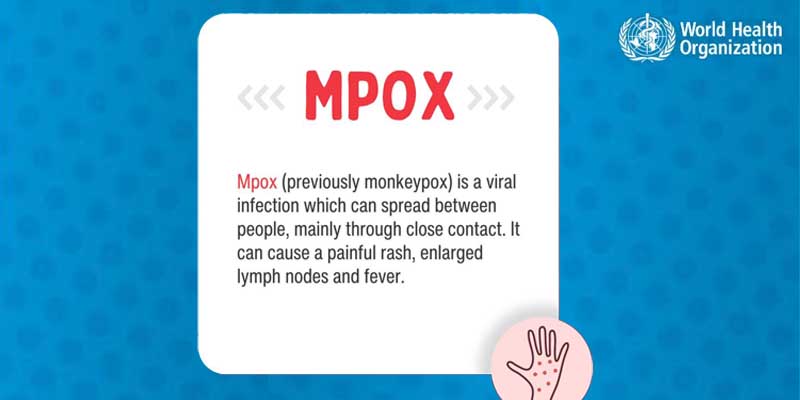- World
- Feb 27
Mpox still a ‘public health emergency of international concern’, says WHO
• The mpox outbreak is still a ‘public health emergency of international concern’ (PHEIC), the World Health Organisation (WHO) said on February 27.
• The WHO, which first declared the emergency in August 2024, said its decision was based on the continuing rise in the number of mpox cases and the geographic spread of the outbreak.
• It added that violence in the eastern Democratic Republic of the Congo, which has hampered its response plan, was also a factor.
• A different form of mpox was also labelled as an emergency in 2022-2023.
• The new form of mpox, clade Ib, continues to predominantly affect the Democratic Republic of Congo, and Uganda and Burundi are also significantly affected, according to a recent report from the WHO.
• There have also been travel-related cases in countries including Thailand and Britain.
What is mpox?
• Mpox (monkeypox) is an infectious disease caused by the monkeypox virus (MPXV).
• Mpox virus belongs to the Orthopoxvirus genus in the family Poxviridae. The Orthopoxvirus genus also includes variola virus (which causes smallpox), vaccinia virus (used in the smallpox vaccine), and cowpox virus.
• Mpox has symptoms similar, but less severe, to smallpox. While smallpox was eradicated in 1980, mpox continues to occur in countries of central and west Africa.
• Mpox is zoonosis: a disease that is transmitted from animals to humans.
• Mpox was formerly called monkeypox. Following a series of consultations with global experts, WHO began using “mpox” as a synonym for monkeypox.
• Monkeypox was first discovered in 1958 when outbreaks of a pox-like disease occurred in monkeys kept for research, hence the name ‘monkeypox’.
• The first human case was recorded in 1970 in the Democratic Republic of the Congo (then known as Zaire), and since then the infection has been reported in a number of central and western African countries. Most cases are reported from Congo and Nigeria.
• In 2003, monkeypox was recorded in the United States when an outbreak occurred following importation of rodents from Africa. Cases were reported in both humans and pet prairie dogs. All the human infections followed contact with an infected pet and all patients recovered.
• Mpox is endemic in densely forested regions of West, Central and East Africa, particularly in the northern and central regions of Congo.
• Mpox outbreaks are caused by different viruses called clades. Clade 1 has been circulating in Congo for years, while clade 2 was responsible for the global outbreak which began in 2022.
Transmission
• Mpox does not spread easily between people.
• Spread of mpox may occur when a person comes into close contact with an animal (rodents are believed to be the primary animal reservoir for transmission to humans), human, or materials contaminated with the virus.
• The virus enters the body through broken skin (even if not visible), the respiratory tract, or the mucous membranes (eyes, nose, or mouth).
Person-to-person spread is very uncommon, but may occur through:
• Contact with clothing or linens (such as bedding or towels) used by an infected person.
• Direct contact with mpox skin lesions or scabs.
• Coughing or sneezing of an individual with a mpox rash.
Symptoms
Initial symptoms include fever, headache, muscle aches, backache, swollen lymph nodes, chills and exhaustion. A rash can develop, often beginning on the face, then spreading to other parts of the body. The rash changes and goes through different stages before finally forming a scab, which later falls off.
Treatment
• Detection of viral DNA by polymerase chain reaction (PCR) is the preferred laboratory test for mpox.
• Mpox, in most cases, is a mild condition which will resolve on its own and have no long-term effects on a person’s health. Most people recover within a few weeks. However, severe illness can occur in some individuals.
• Treatment of mpox patients is supportive dependent on the symptoms. Various compounds that may be effective against mpox virus infection are being developed and tested.
• Prevention and control of human mpox rely on raising awareness in communities and educating health workers to prevent infection and stop transmission.
What is PHEIC?
A PHEIC is defined in the IHR (2005) as, “an extraordinary event which is determined to constitute a public health risk to other States through the international spread of disease and to potentially require a coordinated international response”.
This definition implies a situation that is:
i) Serious, sudden, unusual or unexpected.
ii) Carries implications for public health beyond the affected State’s national border.
iii) May require immediate international action.
WHO has to consider five elements to decide whether an outbreak constitutes a public health emergency of international concern.
They are:
1) Information provided by countries – which in this case shows that the virus has spread rapidly to many countries that have not seen it before.
2) The three criteria for declaring a public health emergency of international concern under the International Health Regulations — being an extraordinary event, a public health risk to other States and a potential need to require a coordinated international response.
3) The advice of the Emergency Committee — which did not reach a consensus.
4) Scientific principles, evidence and other relevant information – which are currently insufficient.
5) The risk to human health, international spread, and the potential for interference with international traffic.
Manorama Yearbook app is now available on Google Play Store and iOS App Store


